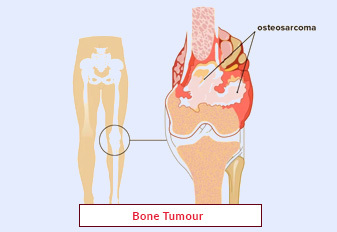Bone Tumor

A bone tumor is an abnormal growth of cells within the bone. These growths can be benign (non-cancerous) or malignant (cancerous). Benign bone tumors are often non-life-threatening and may not require immediate treatment. On the other hand, malignant bone tumors can be aggressive and may spread to other parts of the body. Common symptoms of bone tumors include pain, swelling, and fractures in the affected bone. Diagnosis typically involves imaging tests, biopsies, and sometimes blood tests. Treatment options vary and may include surgery, radiation therapy, chemotherapy, or targeted therapy, depending on the type and stage of the tumor.
Book an AppointmentAbout Bone Tumor
Early diagnosis of a bone tumor is essential for better treatment outcomes. In many cases, benign bone tumors can be effectively managed with surveillance, while malignant bone tumors often require prompt and aggressive treatment, such as surgery, chemotherapy, radiation therapy, or targeted therapy, depending on the specific diagnosis and stage of the tumor.
Symptoms Of Bone Tumor
Symptoms of bone tumors can vary widely depending on the type, location, and stage of the tumor. Some bone tumors may be benign (non-cancerous) and cause mild or no symptoms, while others, particularly malignant (cancerous) tumors, can lead to more severe and noticeable signs. Here are six common symptoms of bone tumors:
-
Localized Pain: Pain is a common symptom of bone tumors. It may be described as a deep, aching pain that worsens at night and with activity. The pain is typically localized to the affected bone or joint. For example, a person with a bone tumor in the leg may experience pain in the thigh or knee. This pain is often progressive and not relieved by rest or over-the-counter pain medications.
-
Swelling and Lumps: The presence of a bone tumor can lead to swelling and the development of palpable lumps or masses in the affected area. The tumor may cause the surrounding tissues to become inflamed and swollen. This swelling is particularly noticeable in the limbs or joints.
-
Fractures: Weakened bones due to a tumor may be more susceptible to fractures. Even minor injuries or activities that typically wouldn't result in a fracture can lead to bone breaks. Pathological fractures, fractures caused by a weakened bone rather than trauma, can be an early sign of a bone tumor.
-
Limited Range of Motion: Tumors that affect joints or nearby tissues can lead to a decreased range of motion in the affected area. This may manifest as stiffness and difficulty moving the joint freely. For example, a bone tumor in the knee joint can cause limited knee movement.
-
Unexplained Weight Loss: In cases of advanced or rapidly growing bone tumors, unexplained weight loss and fatigue may be present. These symptoms are often indicative of more aggressive malignancies that have advanced to a later stage.
-
Neurological Symptoms: In rare cases where a bone tumor affects the spine, it may exert pressure on the spinal cord or nerves. This can result in neurological symptoms such as numbness, weakness, or changes in bowel or bladder function. These symptoms are more common with chordomas or aggressive spinal tumors.
Bone Tumor Treatment
The treatment of bone tumors is a complex and multidisciplinary process that depends on the type of tumor, its location, stage, and the overall health of the patient. The primary goal of treatment is to remove or control the tumor while preserving the function and stability of the affected bone and surrounding tissues. Here are the key treatment options for bone tumors:
-
Surgery:
- Surgery is often the primary treatment for both benign and malignant bone tumors. The surgical approach can vary from minimally invasive techniques, such as arthroscopy or curettage, to more extensive procedures like limb-sparing surgeries or amputations. The choice of surgery depends on the tumor's type and location. In some cases, the surgeon may remove only the tumor (curettage), while in others, a portion of the bone or the entire bone may need to be removed (resection). Reconstruction techniques may be employed to preserve limb function and appearance.
-
Chemotherapy:
- Chemotherapy is a systemic treatment that uses drugs to target and kill cancer cells. It is primarily employed in the treatment of malignant bone tumors, such as osteosarcoma, Ewing sarcoma, and chondrosarcoma. Chemotherapy may be administered before surgery (neoadjuvant) to shrink the tumor, after surgery (adjuvant) to kill any remaining cancer cells, or as the primary treatment for tumors that cannot be removed surgically.
-
Radiation Therapy:
- Radiation therapy uses high-energy X-rays or other particles to target and destroy cancer cells. It is often used for certain bone tumors, particularly those located in the spine, skull, or pelvis, where surgery may be challenging. Radiation can also be used in combination with surgery or chemotherapy for more comprehensive treatment.
-
Targeted Therapy:
- Targeted therapies are drugs that specifically target molecular or genetic abnormalities present in some bone tumors. These therapies can be used in conjunction with other treatments, particularly for patients with conditions like giant cell tumors or chordomas.
-
Radiofrequency Ablation:
- Radiofrequency ablation (RFA) is a minimally invasive procedure that uses heat generated by high-frequency radio waves to destroy tumor tissue. It is often used for small, benign bone tumors and is considered a less invasive alternative to surgery.
-
Cryotherapy:
- Cryotherapy involves freezing the tumor tissue to destroy it. This method is used in selected cases, typically for benign bone tumors.
-
Bone Marrow Transplant:
- For some bone cancers, such as multiple myeloma, a bone marrow transplant may be considered to replace damaged bone marrow with healthy cells. This is typically done after high-dose chemotherapy or radiation therapy.
-
Palliative Care:
- In cases where bone tumors are advanced and cannot be fully treated, palliative care focuses on symptom management, pain relief, and improving the patient's quality of life.
-
Surveillance:
- Some small, slow-growing benign bone tumors may not require immediate treatment. In these cases, the approach may involve close monitoring with regular imaging studies to track the tumor's growth.
The choice of treatment depends on various factors, including the tumor's type, size, location, the extent of its spread, and the patient's overall health. Treatment plans are often developed by a multidisciplinary team of healthcare professionals, including orthopedic surgeons, oncologists, and radiologists.
Timely and accurate diagnosis is critical in determining the most appropriate treatment strategy for bone tumors. Patients should discuss their options with their healthcare team and, if necessary, seek a second opinion to make informed decisions about their care.
Types Of Bone Tumor
Bone tumors can be categorized into several types based on their characteristics, behavior, and whether they are benign or malignant. Understanding the different types of bone tumors is crucial for accurate diagnosis and appropriate treatment. Here are the primary categories of bone tumors:
-
Benign Bone Tumors:
-
Osteochondroma: The most common benign bone tumor, often found in the long bones, such as the arms and legs. It consists of a bony outgrowth covered by cartilage.
-
Enchondroma: A tumor that develops in the cartilage within the bone and is typically benign. It can be found in the hands and feet.
-
Giant Cell Tumor: These tumors are usually benign but can be locally aggressive and grow in the ends of long bones.
-
Osteoid Osteoma: A small, benign tumor that primarily affects young people, causing pain, especially at night.
-
-
Malignant Bone Tumors:
-
Osteosarcoma: The most common primary malignant bone tumor, often occurring in the long bones, particularly around the knee.
-
Chondrosarcoma: A malignant tumor that originates in the cartilage and is more common in older adults.
-
Ewing Sarcoma: Typically affects children and young adults, and can develop in bones or soft tissues. It's an aggressive tumor that requires prompt treatment.
-
Chordoma: A rare but slow-growing malignant tumor that typically occurs in the skull base or the spine.
-
-
Metastatic Bone Tumors:
- Secondary bone tumors, or metastatic bone tumors, occur when cancer from another part of the body spreads (metastasizes) to the bones. These tumors are not primary bone cancers but are treated as bone metastases.
Procedure of Bone Tumor
The procedure for treating bone tumors varies significantly based on the type of tumor (benign or malignant), its location, size, and the overall health of the patient. Treatment often involves a multi-disciplinary approach, with a team of medical professionals collaborating to determine the most suitable course of action. Here is a general outline of the procedure for treating bone tumors:
- Diagnosis and Staging:
-
- The process begins with a thorough diagnosis, which may include imaging tests (X-rays, CT scans, MRIs, or PET scans), biopsies to analyze tissue samples, and blood tests. Staging, which determines the extent and aggressiveness of the tumor, is crucial for planning treatment.
- Consultation and Treatment Planning:
- Once a diagnosis and staging are established, the patient consults with a medical team consisting of orthopedic surgeons, oncologists, and radiologists. Together, they develop a comprehensive treatment plan tailored to the individual patient.
- Surgery:
- Surgery is often a central component of bone tumor treatment. The surgical approach varies based on the tumor type and location. Procedures can range from minimally invasive surgeries (arthroscopy, curettage) to more extensive ones, such as limb-sparing surgeries or amputations. Surgeons aim to remove the tumor while preserving the function and stability of the affected bone and nearby tissues.
- Chemotherapy:
- For malignant bone tumors like osteosarcoma, Ewing sarcoma, and chondrosarcoma, chemotherapy may be administered. This systemic treatment uses drugs to target and kill cancer cells. It can be given before surgery (neoadjuvant), after surgery (adjuvant), or as the primary treatment for inoperable tumors.
- Radiation Therapy:
- Radiation therapy employs high-energy X-rays or other particles to target and destroy cancer cells. It is often used for bone tumors located in challenging surgical areas, such as the spine, skull, or pelvis. Radiation can be delivered before or after surgery, in combination with chemotherapy, or as a standalone treatment.
- Targeted Therapy:
- Targeted therapies are drugs designed to target specific molecular or genetic abnormalities present in some bone tumors. They can be used in conjunction with other treatments, especially for patients with conditions like giant cell tumors or chordomas.
- Radiofrequency Ablation (RFA):
- RFA is a minimally invasive procedure that uses heat generated by radio waves to destroy tumor tissue. It is often applied to small, benign bone tumors, and it offers a less invasive alternative to surgery.
- Cryotherapy:
- Cryotherapy involves freezing the tumor tissue to eliminate it. This approach is used in selected cases, primarily for benign bone tumors.
- Bone Marrow Transplant:
- In certain cases, such as multiple myeloma, a bone marrow transplant may be considered to replace damaged bone marrow with healthy cells, usually after intensive chemotherapy or radiation therapy.
Require Assistance?
Get A Quick Callback From Our Healthcare Experts
Other Specilities We Cover

Anterior Cruciate Ligament (ACL)

Hip Replacement




